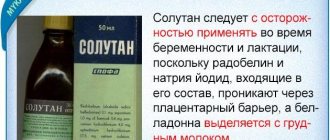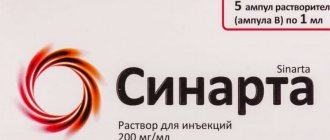Publications in the media
(Diazepamum) INN Synonyms. Valium, Relanium, Seduxen, Sibazon. Composition and release form. Diazepam tablets 0.005 g; 0.5% solution for injection in ampoules of 2 ml, suppositories of 0.005 g. Indications . Neuroses, psychopathy, neurosis-like and psychopath-like states in schizophrenia; organic brain lesions, cerebrovascular diseases; somatic diseases accompanied by signs of emotional stress, anxiety, fear, increased irritability, senesto-hypochondriacal, obsessive and phobic disorders; sleep disorders; relief of psychomotor agitation and anxious agitation; complex treatment of withdrawal syndrome in alcoholism; epilepsy, treatment of convulsive paroxysms, mental equivalents, relief of status epilepticus; spastic conditions; preoperative preparation of the patient; itchy dermatoses; as a sedative and hypnotic for patients with gastric ulcers and heart rhythm disturbances. Pharmachologic effect. Diazepam is one of the main tranquilizers of the benzodiazepine series, which causes anxiolytic, hypnotic, anticonvulsant and muscle relaxant effects, enhances the effect of hypnotics, narcotic, neuroleptic, and analgesic drugs.
Benzodiazepines (diazepam) act as CNS depressants, causing depression at all levels of the central nervous system, and, depending on the dose, can have mild sedative-hypnotic effects or lead to coma. The drug relieves emotional stress, reduces feelings of anxiety, fear, and restlessness. The influence of diazepam on the limbic system determines its psychotropic effect. In addition, its inhibitory effect on the activating part of the reticular formation of the brain stem is of some importance. When diazepam is introduced into the body, the drug interacts with benzodiazepine receptors, which are closely related to GABA-A receptors. Stimulation of benzodiazepine receptors by the drug leads to activation of the GABA-A receptors associated with them, which ultimately manifests itself in obtaining a GABA-mimetic effect. GABA inhibits the transmission of nerve impulses and is a mediator of pre- and postsynaptic inhibition in all parts of the central nervous system. Benzodiazepines help facilitate and implement the inhibitory effect of GABA. Pharmacokinetics. Diazepam is well absorbed from the gastrointestinal tract into the blood. When administered intramuscularly, the drug is absorbed more slowly and at an inconsistent rate. The drug is metabolized in the liver by oxidation into both active and inactive metabolites. With long-term use of diazepam, both diazepam itself and its active metabolites accumulate. Cumulation continues until the equilibrium concentration of the drug in the blood plasma is reached, usually within 5 days - 2 weeks from the start of therapy. After completion of treatment, elimination of diazepam occurs slowly, since active metabolites can remain in the blood for several days or even weeks, resulting in a persistent tranquilizing effect. The drug and its main metabolites are excreted mainly in the urine in the form of glucuronide conjugates.
Side effects. Drowsiness, slight dizziness, ataxia; skin itching; nausea, constipation; menstrual irregularities, decreased libido. Contraindications. Impaired liver and kidney function; myasthenia gravis; severe chronic obstructive pulmonary diseases; comatose states; hyperkinesis; severe depression; organic brain diseases; hypersensitivity to the drug. Adverse reactions when interacting with other drugs. When diazepam is taken simultaneously with alcohol, a sharp potentiation of the effects of alcohol is observed. Medicines that cause depression of the central nervous system (neuroleptics, narcotic analgesics), when taken with diazepam, can cause an increased inhibitory effect on the central nervous system, which can lead to the development of toxic effects and, first of all, inhibition of the respiratory center by these drugs. When cimetidine, estrogen-containing OCs, disulfiram, erythromycin are used together with diazepam, the metabolism of diazepam in the liver is inhibited due to the inhibition of microsomal liver enzymes by these drugs, which leads to a slower elimination of diazepam and an increase in its plasma concentration in the blood.
Antacids reduce the absorption of diazepam. When omeprazole is used concomitantly with diazepam, the elimination time of diazepam may be prolonged. Carba-mazepine and rifampicin, being inducers of microsomal liver enzymes, when combined with diazepam, lower the serum concentrations of the latter and reduce its T1/2. Blood pressure lowering agents may enhance the hypotensive effect of benzodiazepines (diazepam) when administered concomitantly. Premedication with diazepam followed by the use of neuroleptanalgesia (fentanyl and haloperidol) increases the risk of severe hypotension, which is associated with a decrease in systemic vascular resistance, respiratory depression and prolongation of recovery time from anesthesia. The simultaneous use of diazepam with isoniazid may inhibit the elimination of diazepam, which leads to an increase in its concentration in the blood plasma. Sibazon solution should not be administered in the same syringe with other drugs to avoid precipitation. Information for the patient. Diazepam is used orally, starting with a dose of 0.0025-0.005 g 1-2 times a day after meals, then the dose is gradually increased. Extended-release diazepam capsules should be swallowed whole without breaking or chewing. Elderly and senile patients are more sensitive to the effects of diazepam, so they need to reduce the dose. During diazepam therapy, it is recommended to refrain from driving vehicles and performing work associated with increased mental and physical reactions. Diazepam may depress breathing, especially in the elderly, very young children, patients with limited pulmonary reserve, and the seriously ill. Missed dose: take as soon as you remember the missed dose, but no later than 1 hour after the missed dose; if more time has passed, then do not take the missed dose at all; do not take double doses. During treatment with diazepam you should refrain from drinking alcoholic beverages.
Indications for use of the drug Diazepam
Orally for symptomatic treatment of patients in a state of anxiety (may manifest as pronounced anxious mood, behavior and/or its functional, vegetative or motor equivalents - palpitations, excessive sweating, insomnia, tremor, restlessness, etc.), agitation and tension in neuroses and transient reactive states; as an adjuvant for severe mental and organic disorders. Parenterally used to provide a sedative effect before stressful therapeutic or diagnostic procedures, such as electrical pulse therapy, cardiac catheterization, endoscopy, some X-ray examinations, small operations, reduction of dislocations and repositioning of bones in fractures, biopsy, dressing of burn wounds, etc.; to eliminate anxiety, fear, prevent acute stress; for premedication before surgery in patients experiencing a feeling of fear or tension; in psychiatry to eliminate the state of excitement associated with acute anxiety and panic, as well as motor agitation, paranoid-hallucinatory states, and alcoholic delirium; for emergency treatment of status epilepticus and other convulsive conditions (tetanus, eclampsia); in order to facilitate the course of the first stage of labor. Both routes of administration are used to eliminate reflex muscle spasms due to local damage (trauma, wound, inflammation); as an effective adjuvant for the relief of spastic conditions caused by damage to spinal and supraspinal interneurons (for example, with cerebral palsy and paraplegia, with athetosis and rigor syndrome).
Side effects of the drug Diazepam
Most often - lethargy, drowsiness and muscle weakness (usually depends on the dose); rarely - confusion, constipation, depression, dullness of emotions, decreased attention, diplopia, dysarthria, headache, hypotension, urinary incontinence, increased or decreased libido, nausea, xerostomia or increased salivation, skin rash, slurred speech, tremor, delay urine, headache, dizziness, blurred vision; very rarely - increased activity of transaminases and alkaline phosphatase, as well as jaundice. Paradoxical reactions such as acute agitation, anxiety, sleep disturbances and hallucinations have been described; If they occur, diazepam should be discontinued. With parenteral use - thrombosis and thrombophlebitis, local irritation (especially after rapid intravenous administration). Diazepam solution should not be injected into very small veins; It is unacceptable to administer intravenously and get the solution into adjacent tissues. IM injections may be accompanied by pain and erythema.
special instructions
An IV solution of diazepam should be injected slowly into a large vein over at least 1 minute for every 5 mg (1 ml) of the drug. It is not recommended to carry out continuous intravenous infusions - sedimentation and adsorption of the drug by polyvinyl chloride materials of infusion balloons and tubes is possible. During treatment, patients are strictly prohibited from drinking ethanol. In case of renal/liver failure and long-term treatment, monitoring of the peripheral blood picture and liver enzymes is necessary. The risk of developing drug dependence increases when using large doses, a significant duration of treatment, and in patients who have previously abused ethanol or drugs. Should not be used for a long time without special instructions. Abrupt cessation of treatment is unacceptable due to the risk of life-saving syndrome. It has a toxic effect on the fetus and increases the risk of birth defects when used in the first trimester of pregnancy. Taking therapeutic doses later in pregnancy may cause depression of the newborn's central nervous system. Chronic use during pregnancy can lead to physical dependence (possible “flaccid baby” syndrome) and metabolic disorders in response to cold stress. During the treatment period, care must be taken when driving vehicles and engaging in other potentially hazardous activities that require increased concentration and speed of psychomotor reactions.
Drug interactions Diazepam
Concomitant use of cimetidine (but not ranitidine) reduces the clearance of diazepam. There are also reports that diazepam interferes with the metabolism of phenytoin. There is no data on interaction with antidiabetic agents, anticoagulants and diuretics. In the case of combined use of diazepam and neuroleptics, tranquilizers, antidepressants, hypnotics, anticonvulsants, analgesics and anesthetics, mutual potentiation of effects is possible. Diazepam in the form of an injection solution cannot be mixed in the same volume with other solutions, as this may lead to precipitation of the active substance.
Diazepam overdose, symptoms and treatment
Manifested by severe sedation, muscle weakness, deep sleep or paradoxical arousal. Intentional or accidental overdose of diazepam is rarely life-threatening. Significant overdose, especially in combination with other centrally acting drugs, can cause coma, areflexia, depression of cardiac and respiratory activity and respiratory arrest. Treatment - in most cases, only monitoring of vital functions is required. In case of severe overdose, appropriate measures are necessary (gastric lavage, mechanical ventilation, measures to maintain cardiovascular activity). The benzodiazepine antagonist flumazenil is recommended as a specific antidote.
List of pharmacies where you can buy Diazepam:
- Moscow
- Saint Petersburg
Medicinal properties
The drug belongs to the group of tranquilizer drugs. The active substance is a benzodiazepine derivative – diazepam. The substance has the ability to have axiolytic, sedative, and anticonvulsant effects. In addition, drugs based on it also have a muscle relaxant effect.
The mechanism of action of diazepam is achieved through its ability to inhibit GABA activity in the central nervous system.
After penetration into the body, the substance is absorbed at a high speed, peak concentration in plasma is formed after an hour and a half. Diazepam is highly active: it penetrates into all internal fluids: it passes through the placental barrier, is excreted into breast milk, and penetrates the spinal cord.
Metabolic transformations occur in the liver, and the substance is excreted from the body by the kidneys.
Analogs
Synonyms of Diazepam: Apaurin, Valium, Diazepabene, Seduxen, Relium, Sibazon, etc.
Reladorm
Tarchomin Pharmaceutical Works Polfa. (Poland)
Tranquilizer based on diazepam and cyclobarbital. It is used to treat sleep disorders (insomnia, inability to sleep, frequent awakenings), and eliminate irritability.
The dosage is selected individually for each patient after analyzing the body’s response to the drug. If used to improve sleep, it is recommended to drink 1⁄2-1 tablet. an hour before going to bed.
Pros:
- Calms
- Helps you sleep
- Strong action.
Minuses:
- Side effects.




